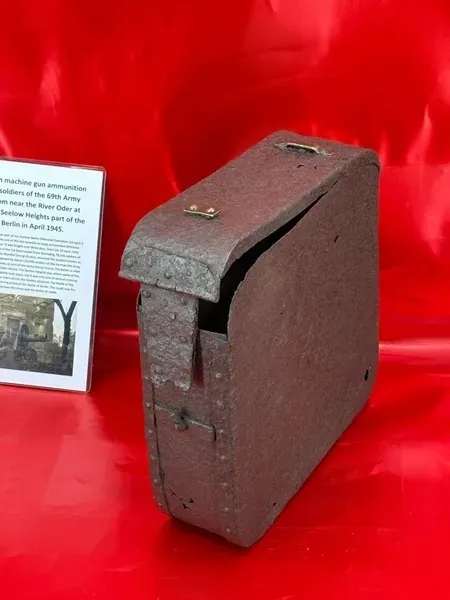 Image 1 of 10
Image 1 of 10

 Image 2 of 10
Image 2 of 10

 Image 3 of 10
Image 3 of 10

 Image 4 of 10
Image 4 of 10

 Image 5 of 10
Image 5 of 10

 Image 6 of 10
Image 6 of 10

 Image 7 of 10
Image 7 of 10

 Image 8 of 10
Image 8 of 10

 Image 9 of 10
Image 9 of 10

 Image 10 of 10
Image 10 of 10











Russian maxim machine gun ammunition tin sed by soldiers of the 69th Army and recovered near the River Oder at Lebus, south of the Seelow Heights April 1945.
This is a Russian Maxim machine gun ammunition tin in solid relic condition. It is rusty, with some rust holes and no visible paintwork remaining. The lid opens and closes, though it does not lock, but the catch and hinge are in good working order. The tin has been thoroughly cleaned and is ideal for display or inclusion in any military collection.
The tin was used by soldiers of the 69th Army and recovered near the River Oder at Lebus, south of the Seelow Heights. It comes with an A5 laminated information card.
Historical context: The Battle of the Seelow Heights was part of the Seelow Berlin Offensive Operation (16 April-2 May 1945). This pitched battle was one of the last large-scale assaults on entrenched German positions during the Second World War, fought over three days (16-19 April 1945). Nearly one million Soviet soldiers of the 1st Belorussian Front, including 78,556 troops of the Polish 1st Army under Marshal Georgi Zhukov, attacked the position known as the Gates of Berlin. They faced roughly 110,000 German soldiers of the 9th Army, commanded by General Theodor Busse, as part of Army Group Vistula.
The Seelow Heights saw some of the fiercest fighting, although it was only one of several crossing points along the Oder and Neisse rivers during the Soviet advance. This engagement is often considered part of the wider Battle of the Oder Neisse, itself the opening phase of the Battle of Berlin. The result was the encirclement of the German 9th Army and the subsequent Battle of Halbe.
This is a Russian Maxim machine gun ammunition tin in solid relic condition. It is rusty, with some rust holes and no visible paintwork remaining. The lid opens and closes, though it does not lock, but the catch and hinge are in good working order. The tin has been thoroughly cleaned and is ideal for display or inclusion in any military collection.
The tin was used by soldiers of the 69th Army and recovered near the River Oder at Lebus, south of the Seelow Heights. It comes with an A5 laminated information card.
Historical context: The Battle of the Seelow Heights was part of the Seelow Berlin Offensive Operation (16 April-2 May 1945). This pitched battle was one of the last large-scale assaults on entrenched German positions during the Second World War, fought over three days (16-19 April 1945). Nearly one million Soviet soldiers of the 1st Belorussian Front, including 78,556 troops of the Polish 1st Army under Marshal Georgi Zhukov, attacked the position known as the Gates of Berlin. They faced roughly 110,000 German soldiers of the 9th Army, commanded by General Theodor Busse, as part of Army Group Vistula.
The Seelow Heights saw some of the fiercest fighting, although it was only one of several crossing points along the Oder and Neisse rivers during the Soviet advance. This engagement is often considered part of the wider Battle of the Oder Neisse, itself the opening phase of the Battle of Berlin. The result was the encirclement of the German 9th Army and the subsequent Battle of Halbe.
